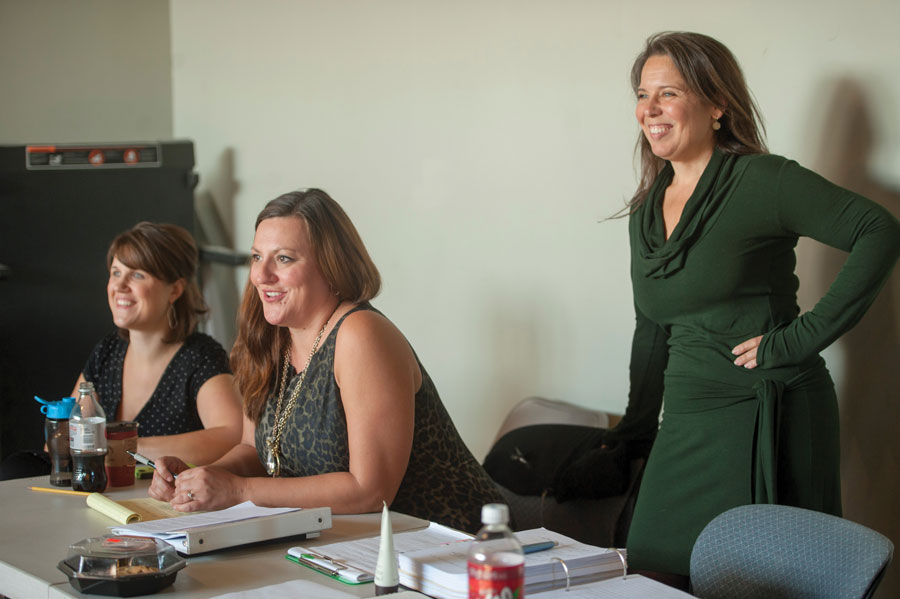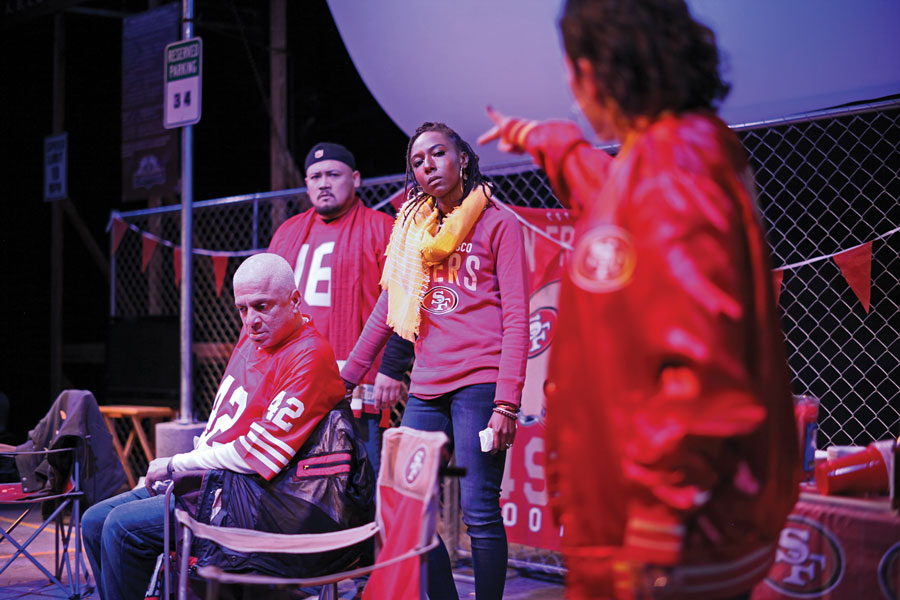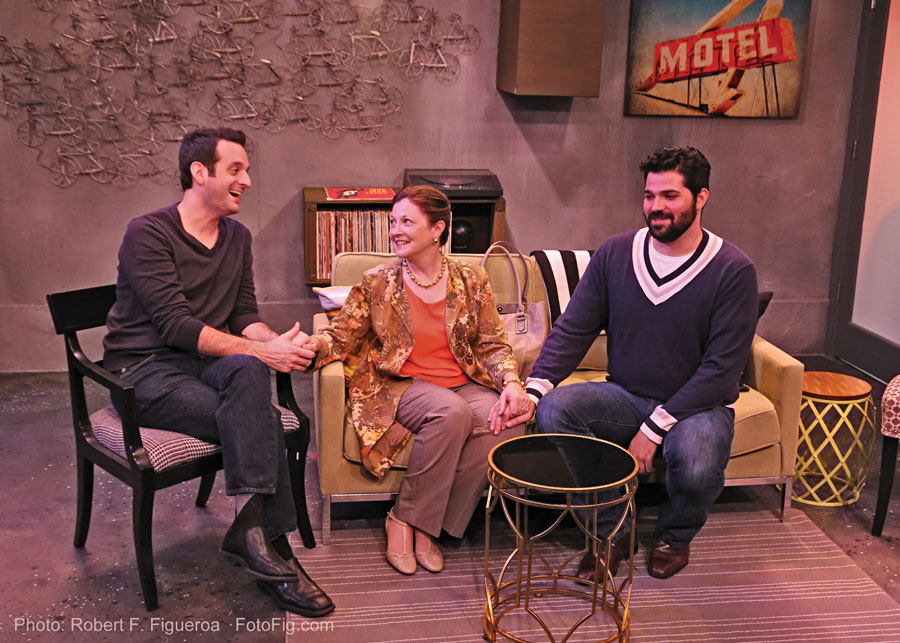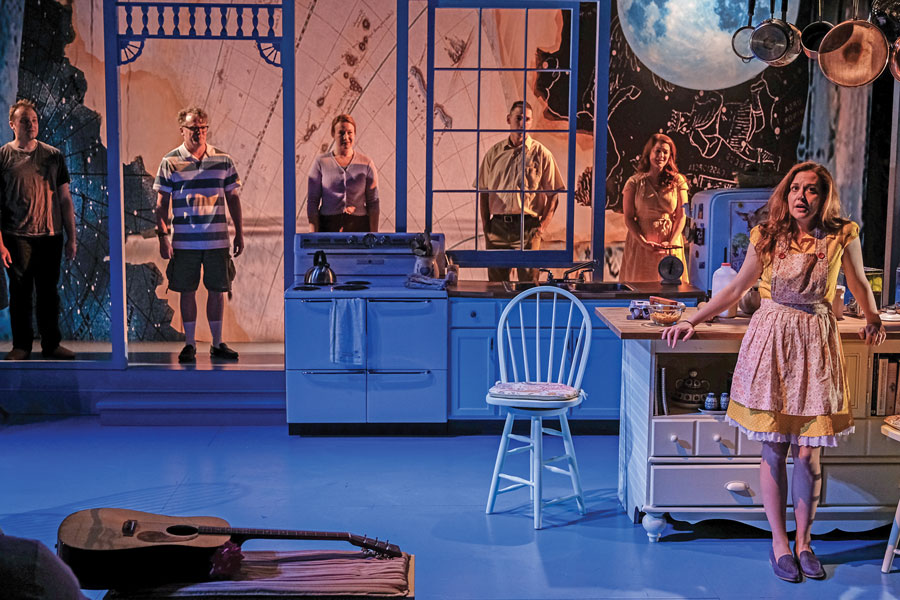Over the course of 90 minutes, the main character of Noah Haidle’s Birthday Candles goes from age 17 to 101. Each scene marks another birthday for Ernestine, who poignantly moves through life’s highs and lows as she prepares a birthday cake before the audience’s eyes.
That flash-forward process is not unlike the story of the theatre that helped birth the play. When it was announced this summer that Birthday Candles would be part of Roundabout Theatre Company’s 2019-20 season, it did not mark the familiar end point of a new play’s long, arduous journey to Broadway. In fact it was a very short trip: Detroit Public Theatre, itself formed in 2015, commissioned the play in the fall of 2016.
This quick success for the theatre, which had a budget of $494,500 for its inaugural season, was a happy surprise, says Sarah Clare Corporandy, who co-leads DPT alongside fellow founders Courtney Burkett and Sarah Winkler. But it hardly came out of the blue. It was instead the result of an intensive process, as is often the case for small theatres, that relied on a lot of hard work, collaboration, and support from others. A grant from the Venturous Theater Fund of the Tides Foundation bankrolled the project, and Corporandy’s connection as managing director of Chautauqua Theater Company in western New York meant it had a venue for a workshop.
“One of the reasons I think we’ve been so successful is because we take risks, and if something feels scary, we kind of feel like that’s the thing we should do,” Corporandy says. A “financially smart but artistically risky” attitude has helped the three DPT co-founders pursue exciting projects on the local and national levels: not only Birthday Candles but also a co-production of Detroit ’67 with Baltimore Center Stage, a LORT theatre with a budget of around $8 million. DPT has fostered connections with Detroit-based and out-of-town artists and has seen its audiences grow to comfortably fill the space it rents from the Detroit Symphony Orchestra.
Yet there are challenges ahead, as DPT works to build on and sustain its quick success. While the artistic product is quite mature, DPT is still a young company, and demand is growing faster than anticipated, Corporandy says. The company’s budget is now just shy of $1 million; bringing in more full-time staff and establishing their own space are priorities that will require additional investment. The three founders share responsibilities, like marketing and fundraising, and have been known to raid their own homes for potential props, not to mention working the occasional 90-hour week.
“Each year we come up for air and are like, ‘Okay, we’ve hired this person part-time and they can do those things that I was doing,’” Corporandy says. “And I lift my head up and there are 20 other things coming down the track that I’ve sort of been holding off that now I can deal with.”
Looking to the future, Corporandy hopes that further growth does not entail compromise.
“We started with no rules—no conventional theatre rules,” she says. “We were building the audience we wanted to reach out to, a diverse, urban audience, we were serving a city, we were making bold choices,” Corporandy says. “We were able to take those risks because we’re not too big yet. And I hope that as we grow, we still find a way to manage risky choices without compromising.”
Running and sustaining a small theatre comes with its share of challenges, as well as unique opportunities: the chance to operate more nimbly and responsively than larger organizations, to reach new audiences, and to make a disproportionate artistic impact. Whether in rural areas or urban settings, in seasonal towns or year-round locations, small arts organizations—defined for our purposes as those with annual budgets under $1 million, though many are much smaller than that—are often the places where artists get early opportunities and underserved communities find a voice.
Located close to the Canadian border, Pendragon Theatre in Saranac Lake, N.Y. (pop. 5,242 as of 2018), isn’t what Kimberley A. Bouchard expected to find when she first visited the region in 1995. A professor of theatre at SUNY Potsdam, Bouchard was floored to discover a production of Waiting for Godot in “the middle of nowhere.” She’s now interim artistic director of Pendragon, which is both a small-town theatre and a seasonal destination.
“We’re the year-round professional theatre in the Adirondacks,” says Bouchard. “In many ways, we don’t get a break.” The theatre’s summer repertory season includes established and newer dramas, comedies, and musicals, plus something for children and theatre camp participants. In the winter and fall, meanwhile, the theatre offers limited runs of plays, as well as holiday shows and readings.
Pendragon also faces challenges distinct to a rural location: Second to personnel, high energy costs comprise a major portion of the budget. Pendragon is fortunate to be located where a community of artists and theatremakers already happen to live, but staffers often wear multiple hats and may switch between full- and part-time roles depending on the season. Looking to the future, Pendragon hopes to raise its budget from just under $400,000 to at least $500,000 and make more staffers full-time.
“We may not be the richest theatre,” Bouchard concedes. “Our success has been instead in believing in that mission of doing excellent theatre and having a strong connection to community. We can keep going because we’ve got that kind of loyalty.”
Investment from local businesses and state government doesn’t hurt. Support from the New York State Council on the Arts allowed the theatre to bring on a full-time marketing director. The position, as well as new ticket packages and business sponsorships, has led to a significant increase in ticket sales, Bouchard says. Growth is expected to continue: In July the theatre learned that a quarter of the $10 million grant from the state’s Downtown Revitalization Initiative will go toward building a venue downtown.

Not all small theatres find success by putting down roots in one location. Many are itinerant, by necessity or by choice, or a combination of both. This gives many the room to experiment, as well as an inherent flexibility—which can be especially important in finding innovative ways to serve audiences.
It was the creation of two successful site-specific productions that first led Baltimore’s Single Carrot Theatre to consider reevaluating its mission after 12 years—and to wonder if it made sense to hold down a permanent location at all, says artistic director and founding ensemble member Genevieve de Mahy. A financial crisis in the summer of 2018 also forced the company’s hand, as it called on grassroots support to raise $55,000 to pay for the cost of maintaining a theatre complex in the Remington neighborhood. As a small organization without excess institutional baggage and a budget of about $400,000, Single Carrot felt free to set a new course, and the troupe ultimately decided to emphasize performing in both traditional and non-traditional theatre spaces. Single Carrot now operates in residence at St. John’s in the Village, an Episcopal church about a mile from its former location, with plans to perform in various locations around the city. In September they opened the new season with a production of Mr. Wolf by Rajiv Joseph, played out in rooms of the church’s former rectory house.
“Once we start doing this and become known in the city for doing this, our hope and goal is that people will reach out to us for space that they have that they want to be activated, and that we could create work around that space,” de Mahy says.
Not having a permanent home can be turned into an aesthetic advantage, and even become something of a brand for a company. When audiences come to a production by Wisconsin’s Music Theatre of Madison, in a rented theatre, bar, or community center, they’re likely seeing a show they haven’t seen before and won’t see again, notes MTM founder and executive director Meghan Randolph. For the company’s production of Arlington by Polly Pen and Victor Lodato—a one-woman show set in the character’s living room—a local coffeehouse was a natural stage.
But going mobile doesn’t necessarily mean costs are low. While previously Single Carrot’s rent held the organization back from improving compensation for artists and administrators, that’s no longer a barrier (the company is non-Equity, though they’ve signed a number of special appearance agreements). “Making theatre takes people,” de Mahy says. “And for a large theatre and a small theatre, in a lot of ways it still takes the same amount of people to do it—it’s just a matter of how much they’re being compensated.”
Inadequate pay at small organizations can make it difficult to attract and retain staff. MTM’s Randolph, who also has a day job doing marketing for a nonprofit serving local seniors, performs her theatre leadership duties on a full-time basis, though she’s “not quite paid full-time. I would love to have more money, obviously, but I don’t want us to get huge,” Randolph says, reporting MTM’s budget at $100,000. “I feel like we can take a lot more risks and move around to different venues and try more things and experiment.”
Staying small and rooted in the community, Randolph argues, is what led this past summer to the company’s first world premiere, Hephaestus, by Madison native Nathan Fosbinder. While developing the show, MTM invited audiences to vote on their favorite set and costume renderings, performed portions of the show for audiences in libraries, and started a dialogue around the work with students at the University of Wisconsin-Madison.
“Musicals take a long time and go through many iterations, and I wanted the audience to have a stake in that,” Randolph says, adding that when MTM received its first national grant, $5,000 from the National Alliance for Musical Theatre, for Hephaestus, she heard it was this community engagement aspect that helped their project stand out.
While a budget of $600,000 to $1 million might be a future sweet spot for Single Carrot, de Mahy says she defines success in relation to the mission, not the budget, of the company—by the way it responds to the urgent questions currently being raised across the entire field. “For us, changing our model is really an experiment in developing a way to answer those questions,” de Mahy says. “To address social justice, to engage audiences, to build community, to connect people to theatre, and also to create theatre that is more of an experience than an entertainment.”

At Campo Santo in San Francisco, no season is announced months ahead of time. The development of new plays directs the action, says co-founder and program director Sean San José.
Though Campo Santo was fortunate to find an immediate home when it was founded in 1996 as the resident theatre company of Intersection for the Arts, it lost that space in 2014 when the nonprofit arts space changed leadership and locations. The theatre went from being physically part of San Francisco’s Mission District, a long-time working-class neighborhood with a large immigrant population, to cycling through a variety of local performance locations.
“Rather than folding in, it’s actually made the group more resilient and, in some ways, maybe more creative in so far as adaptability generates creativity,” says San José. “I think we ground ourselves in being a part of the survivors—a group that speaks for people who were being priced out, a group that speaks for people who grew up here, a group that speaks to inviting in new audiences, new voices, new people to the city.”
In January, Campo Santo sold out its world premiere of Candlestick by Ben Fisher, a play about the changing face of the Bay Area. American Conservatory Theater’s ArtShare initiative made the ACT Costume Shop Theater available for the production. But new recipients for ArtShare are announced each year, and Campo Santo is not part of its current season.
Because Campo Santo is project-based and dependent on grants, the company’s budget can range between $160,000 and $300,000, says San José. Campo Santo has not paid money to build a website, uses Brown Paper Tickets instead of paying for box office infrastructure, and markets via Facebook and Instagram. These aren’t traditional methods, but San José says they work for their community.
“Find the people you want to talk to and create your structure based on that relationship,” San José says. “The existing model of how theatres can be run in the United States is everywhere, so we’re always going to be able to refer back to that. But to model it directly after that doesn’t seem to be very future-making to me.”
Community support was key to the founding of Island City Stage outside Fort Lauderdale, Fla., in 2012. Audiences wanted a space to see works from and for the LGBTQ community, explains founding artistic director Andy Rogow.
“I think what has made us successful is the fact that this really wasn’t an artist-creator theatre company,” Rogow says. “It was created by community members who wanted to have a theatre in their community, and they were willing to do the work and help raise awareness and funds to make it happen.”
Subscribers say they enjoy the intimacy of the 68-seat theatre space the company rents, but Rogow would still like to grow physically and raise the budget above its current $450,000. (He limits the cast size of shows to under 10 people, not because of a lack of funds but because of a lack of space in the venue’s dressing room.)
When the state of Florida cut back on cultural giving in recent years, Island City was less affected than larger organizations, as it depends primarily on its donors. With more funding and attention, Rogow thinks Island City could incubate and commission new work. Daniel’s Husband, by South Florida playwright Michael McKeever, which ran Off-Broadway at Primary Stages in 2017, had its premiere at Island City Stage in 2015.
“Of course, we would like to be bigger,” Rogow says. “We just don’t know exactly how big the potential audience is. We do think that we could get more straight or heterosexual audience members who just like good theatre to come, but because they see, ‘Oh, it’s an LGBT-focused theatre,’ they think that it may not relate to them somehow or they may not find the stories interesting.”

Infusing a local community with the arts or engaging with a diverse and historically underserved audience is often the raison d’être of a small theatre. Su Teatro Cultural and Performing Arts Center in Denver is the largest Latinx arts organization in the state of Colorado, but it was built without early support from major individual donors or state funding. The growth of the company, which will celebrate its 50th anniversary in 2022, has been slow and steady, and having their own venue has been a key factor in their stability and success. Taking advantage of an affordable real estate market in 2010, the theatre moved into their current building when their budget was $388,000. The budget is now just over $1 million, thanks to multi-year funding from the National Performance Network’s Leveraging the Network for Equity initiative, which allowed Su Teatro to pay for plumbing updates required by the city and pay off an old line of credit. If Su Teatro started out with meager support, that is no longer the case: They recently raised more than $125,000 through individual $1,000 donations.
The theatre isn’t the only thing that’s grown in the intervening years. Says Tony Garcia, Su Teatro’s executive artistic director, “Denver is changing tremendously. One time you could drive through the city and there were 15 cranes sticking up out of downtown Denver. Denver’s downtown area has doubled in the last eight years. There’s old downtown Denver and new downtown Denver.”
At Su Teatro, theatremakers hold a mirror up to that change. In June, Su Teatro premiered Northside, about the transformation of a Denver neighborhood, by Bobby LeFebre, recently named the poet laureate of Colorado. By investing in new works by local artists, Su Teatro joins a larger discussion—one that’s happening across the city, state, and country.
Sometimes budget size doesn’t capture a theatre’s true stature. With deep roots and a long history in New Brunswick, N.J., Crossroads Theatre Company hardly qualifies as a small theatre, artistic director Marshall Jones III justly contends. It won the 1999 Tony Award for Outstanding Regional Theatre, having toured the country and internationally and premiering works by the likes of George C. Wolfe. With each production, Jones says he sees the theatre making an impact in the community.
“I know our audiences are very, very diverse, so it’s not just one prominent demographic,” Jones says. “You’re going to have young and old and rich and poor sitting right next to each other. When I’m standing in the wings and I look out in the crowd it represents America, and that I find very exciting.”
Although at one point Crossroads struggled financially, even going so far as to sit out its 2000-01 season, the theatre has been faring better in recent years. While its annual budget had hovered around $600,000, that number has doubled for the troupe’s first season in a new space, which kicked off in September with a production of Paul Robeson at the New Brunswick Performing Arts Center, a new venue that’s home to four artistic organizations in residence.
Overseen by the New Brunswick Development Corporation, and completed in partnership with local and state governments as well as Rutgers University, this 435,000-square-foot project is located on Crossroads’ former site, but now includes space for multiple theatres, studios, offices, and a 207-unit residential rental apartment tower. The developers plan to partner with the Actors Fund to advertise the units to artists and arts professionals.
If Crossroads could ever have been called a small theatre, then you certainly couldn’t call it that now. From weathering the Great Recession to providing a platform to playwrights, Crossroads has maintained a level of artistic excellence that makes a difference, first in its own community and later beyond, Jones says. It also provides a handy example of a theatre managing its growth without compromising its identity. Indeed the current season is built around productions that have some connection to Crossroads history: not just the Robeson play but a multiracial Christmas Carol and a new play, Freedom Rider, directed by one of Crossroads’s co-founding leaders, Ricardo Khan. Even as its audience size and artistic ambitions increase with its budget, Jones says he expects the relationships the theatre has forged to only deepen.
“The role that Crossroads is filling now is just as important as it was in 1978,” says Jones. In today’s easily distracted culture, let alone in the ephemeral realm of the theatre, that is no small thing.
Dara McBride, a former intern of this magazine, is an arts writer based in Delaware.


